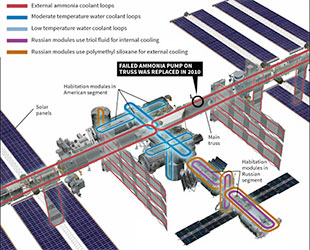 advertisements advertisements
|

|
Space station cooling system shuts down, some systems offline

The International Space Station, seen here in May 2010, suffered a coolant system shutdown Wednesday, Dec. 11, 2013. (NASA) |
Dec. 11, 2013 — The International Space Station suffered a problem with half of its vital cooling system Wednesday (Dec. 11), resulting in a partial power down of some non- critical systems, NASA officials say.
According to a NASA statement, "at no time was the crew or the station itself in any danger." The six astronauts and cosmonauts aboard the orbiting laboratory went to sleep as regularly scheduled with no concern for their safety, the statement said.
On Wednesday, one of the two pumps used to circulate ammonia coolant on the outside of the space station shut down after lower than normal temperatures were detected. The shutdown cut off half of the space complex's ability to regulate the temperatures for both its internal and external systems. [SPACE.com: How the Space Station's Cooling System Works (Infographic)]
By midday, flight controllers suspected that a flow control valve inside the pump might not be functioning correctly. NASA capcom (capsule communicator) Lucia McCullough described the "big picture" to the station's crew members during their normal daily planning conference call.
"The ETCS [External Thermal Control System] Loop A is still running but the flow control valve doesn't appear to be positioning properly, so the Loop A is very cold," radioed McCullough around noon EST on Wednesday. "We are not expecting [the loop] to get warm enough for us to be able to reintegrate [Loop A] for heat rejection."

Infographic illustrating how the International Space Station (ISS) cooling (thermal control) system works. (SPACE.com/Karl Tate) |
McCullough told the crew that as a result of the shutdown, science experiments and other hardware inside the U.S. Harmony Node 2 module, European Columbus laboratory and Japanese Kibo laboratory would be powered down as they slept.
"You'll keep half of [the power to] each module and that is why the crew quarters are not affected," McCullough said from NASA's Mission Control Center in Houston.
Meanwhile, the space station's more critical systems are being cooled by Loop B, which is still functioning normally.
"All the thermal loops have been shifted to Loop B, which is struggling to keep up, so we are going to be looking at some additional power downs in other modules to make sure that the highest priority loads get adequate cooling," McCullough told the crew.
Ground controllers are continuing to troubleshoot the issue overnight, according to a statement on NASA's website. If the valve issue turns out to be a hardware problem, it may require astronauts go outside the station at some point to replace the pump module with a spare unit.
The affected 780-pound (355 kilogram) pump module was last replaced by station astronauts in August 2010 during three contingency spacewalks, the result of a similar Loop A coolant system shutdown. In that situation however, the pump module itself had failed rather than the control of a valve, as currently suspected.
The coolant issue notwithstanding, as of Wednesday night NASA and its commercial partner Orbital Sciences Corp. were still preparing to launch Orbital's Cygnus unmanned resupply spacecraft to the space station next Wednesday (Aug. 18) from the space agency's Wallops Flight Facility in Virginia. The Orb-1 mission is the first of eight resupply flights NASA has contracted Orbital Sciences to fly to the space station.
The International Space Station, which last month marked 15 years in orbit, is currently staffed by its 38th expedition crew, including NASA astronauts Mike Hopkins and Rick Mastracchio, Koichi Wakata with JAXA, and cosmonauts Oleg Kotov, Sergey Ryazansky and Mikhail Tyurin. |

© 2023 collectSPACE.com All rights reserved.
Questions? E-mail [email protected]

|
|

|

|
